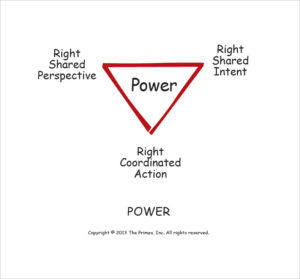This thought leadership post is focused on the importance of leadership alignment, so you may be surprised by my next statement. Leadership alignment is a highly unnatural act – and it’s almost always a temporary state. Achieving it – even temporarily – is a huge challenge; however, it’s critical if leaders intend to effect meaningful organizational change.
How Do I Know if We’re Aligned – or Aren’t?
It’s easy to assume the signs of an out-of-sync leadership team are obvious. Some are; while others may be more difficult to spot.
For example, poor financial performance may be reflective of more than a down market or changing customer priorities. An out-of-sync leadership team may result in competing priorities that strain resources, leading to underperformance on the balance sheet.
For many of the same reasons, employee sentiment and customer experience scores can serve as leading indicators of leadership discord; so too can client and employee retention rates. Those same competing priorities may lead to unclear employee expectations that manifest in sub-par customer experience, leading both team members and employees to consider other options.
In short, any time your organizational system feels off-kilter, take a temperature check before ruling out leadership alignment as the culprit.
However, leadership alignment doesn’t equal a steady state – that’s stasis. When leaders are aligned, I expect to see evidence of growth along multiple trajectories: financial growth; intellectual growth; and community growth. Those are the indicators that alignment exists clearly enough to push an organization into its next phase. But as I mentioned, alignment can be fleeting – what’s working this year may not in the next, making the pursuit of alignment ongoing.
Leadership Alignment, Clearings, and the Power PRIME
At The Clearing, we define leadership alignment as shared clarity on the end state or desired future state of where the organization desires to go or achieve. To pressure test that clarity, we undertake the following critical exercises.
- First, we determine the value of that end state to our customers. For example, how bad do they want or need to get there; how will it allow them to better serve their stakeholders; etc.
- Second, we seek a thorough and shared understanding of the current state to serve as our measurement baseline.
- Third, we codify alignment on what the organization is measuring as a result of their desired shift. This may ladder back to the indicators I shared above: financial performance, retention rates, employee satisfaction, etc.
We use the Power PRIME to guide us through this exercise.

Individuals cannot solve the problems we face today regardless of their power in a vacuum. It takes many people coming together powerfully to cause sustainable solutions to our problems. The power they have the potential energy to generate is a function of:
- The degree to which they operate from a shared perspective,
- The intensity of their shared intent, and
- Their commitment to taking synchronized and coordinated action.
This PRIME is a good indicator of where leadership alignment must exist at the highest level to reach the desired end state. If you have alignment in those three areas, shared understanding of the current state, and shared understanding of the intent, setting priorities and responsibilities is made easier.
As our co-founder, John Miller, recently wrote, this stage is where “clearings” become beneficial. Between the rigors of day-to-day life and a stream of distractions, we know how hard it is for leaders find the space to have these conversations. It’s especially hard for leaders with accountability over different functions and stakeholders to spontaneously manifest the same notion of how they both need to move forward in service of shifting their organization toward the desired future state.
Creating an environment where leaders can have the best version of that conversation is critical to facilitating leadership alignment. Driving change means changing the day-to-day; getting out of the day-to-day often helps make it clear what needs to change.
The Bottom Line
As a leader, you are in a position to both reap the benefits of alignment with your peers and serve as a first warning for when things get out of sync. This applies whether you are trying to effect specific change or simply meet ongoing operational objectives.
Here are three tenets to keep in mind as you observe your organization:
- Stay Aware: Monitor the indicators I shared above. Those undercurrents of unalignment may be what point to the need for change. And remember, it’s not always negatives that lead to issues. An amazing new leader may join your organization. It may be a long-term positive; however, it is still a source of disruption.
- Leverage the Power PRIME: If you observe unalignment, or find it difficult to achieve common ground when working toward objectives, consider employing the Power PRIME to align and prioritize.
- Be Consistent: Leadership alignment is temporary. It’s not set-it-and-forget-it – it’s something that requires consistent work.
We’ll be covering more on leadership here in the near future. In the meantime, you can learn more about The Clearing’s approach to leadership in a post authored by Sonya Patel, who heads our Leadership Solution Area. And of course, I’d love to chat more about your specific leadership or organizational goals – you can reach me at Tara.Carcillo@theclearing.com.








 The Clearing’s Employee Experience
Improvement model, adapted from Itam
& Ghosh, 2020, focuses on three objectives:
The Clearing’s Employee Experience
Improvement model, adapted from Itam
& Ghosh, 2020, focuses on three objectives: 












